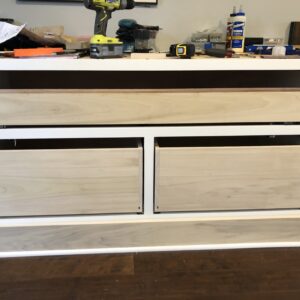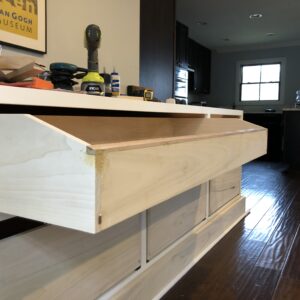Challenging false drawer front design issue
In the process of building a built-in cabinet + bookshelf in my living room. Project is going well, but I’ve got a design challenge I haven’t been able to solve. Hoping the minds here have some ideas.
First some background. My built-in has a wide center cabinet that measures 56 1/4″ across. The reason it’s so wide is that the top drawer in that cabinet – which runs the width of the cabinet – will hold a digital piano. The piano slides out in a drawer and locks into place for playing. The drawer is already built/installed and works perfectly… the front edge of the drawer is about 2.5″ low (below the piano’s keys) to facilitate play and access.
The issue is the drawer front for the piano drawer… I don’t want the drawer to be visible all the time, I want to be able to hide it with a normal looking front that matches the other drawers in the built-in. So, I need a way to have the drawer front fold down or up out of the way to slide out the piano. The issue is that, with undermount slides on that drawer, there isn’t a lot of room for secondary door support (1/4″ on the sides, 5/8″ below, 2 1/4″ above).
As an additional wrinkle the cabinet is full overlay with a face frame (the fronts will have 1/4″ between them). So, whatever hinging system I come up with will have to facilitate the overlay. The overlay on the drawers will be 5/8″.
My ideal solution is to have the drawer front just fold down to 90 degrees (parallel to the drawer) so the drawer can slide out over it. However, to do this I either need to find some load bearing drop hinge or low profile side supports that can fit in the 1/4″ gap on the drawer sides (cable maybe?).
If anyone has any ideas or thoughts I’d love to hear them.
Thanks,
Rick
















Replies
Never built something like this, but we have a cheap piece of junk table with drawer for keyboards. It slides out then the front hinges down. Not sure if it would work for you, but its hopefully and idea to spark your imagination.
One possibility is to attach the drawer front with magnets. Then you would detach it and set it aside while playing the piano.
Mike
There is probably hardware for just this purpose, but I can't say for certain. But I was wondering if a flip-down front would get in the musician's way.
I was also thinking about magnets to hold it on. Add a couple of indexing pins so the false front gets realigned each time.
I decided against attaching a flip front to the drawer for exactly that reason... it would have to fold down into the player's lap or block his legs.
Basically the drawer front either needs to come off or attach/fold on the cabinet itself, allowing the drawer to pass it and extend beyond it (keeping the front at the cab).
The magnet idea you and Mike mentioned would work, but I reeasllly don't like it. Basically I just don't like the idea of having to remove and replace the front, seems like too much to do and less slick.
I actually found this drop hinge from Sugatsune... it's made for full overlay drawer fronts and allows up to a 5/8 overlay, which is exactly what I need. The only problem is that I can't figure out if it's load bearing, and if it isn't (seems likely) I'll still need some kind of thin support on the left and right sides to keep the front from falling past 90 degrees.
https://www.sugatsune.com/site-assets/201B_PDF/238.pdf
-rt
110 (or more) degree overlay cup hinges that open up, not down. There are low-profile hinges out there, or you could reverse them and put the cup inside the cabinet and the plate on the door.
Looks like you have more wiggle room above than below.
Interesting, do you happen to have a link to an example I could see?
I do have a little more room above than below, but not much... the sides of the drawer are cut at slight angles to make the piano more approachable, leading to the 2.25" space. However, as the drawer slides out a lot of that disappears... towards the back it reduces to 3/4". :(
No, no link, just thought of it looking at a cabinet door..."What if you mount these backwards?" Easy enough to mock up with a pair of hinges and some scraps. It would all depend on where the hinge arms wind up on a closed "door".
Have you looked into butler tray hinges? They would be be tricky to install with the cabinet already built but it doesn't have to be a perfect installation since you will never see the flap under the drawer. The barrel would be exposed on the bottom of the drawer face but I don't think it would be objectionable. It might be worth picking up a pair and doing a mock up to see if it would work.
I have, but then issue with butler hinges is the overlay... the front will have about a 5/8" overlay, and butler hinges only work (afaik) with inset/flush mounted panels. The bottom edge of the front would never rotate.
That said, per my msg above I did find some butler like hinges from Sugatsune that do the same thing but provide for a 5/8" overlay. The big issue is whether they're load bearing and can hold that front at a 90 degree angle.
https://www.sugatsune.com/site-assets/201B_PDF/238.pdf
If I can't find a better solution I'll probably buy 3-4 of the Sugatsune hinges, install them, and then hope the hinge and the pressure of the front bottom edge against the face frame can hold it where it needs to be.
What I really need is some kind of thin shelf brace... I've been looking for a heavy wire/cable type system (think stiff piano wire) that I could run through a small eye that I secure on the right and left sides of the cabinet (I could get those under 1/4" from the sides) and then secure near the top corners of the front. The issue is that I can't find them... all I find are those rod type sliding supports, all of which require a minimum of 1/2"-3/4" of clearance.
This is a real head-scratcher, especially with the design constraint.
I think you are going to have to re-make the piano drawer.
I don't think a fold-down front will work, at least not one that is attached to the frame. If you could make the drawer narrower, you could fit in folding stays at the sides, but you still end up with the bottom of the false front being likely to foul on the piece below.
You might be able to set the drawer in a bit further though and that would allow full-overlay euro cabinet hinges, but they will require about 2" in front of the drawer and of course also about 3/4" underneath for clearance.
Instead, I would re-make the sides with a radius on the bottom at the front. This would then allow the front to drop down below the drawer on a bracket (I would use a triangular piece of brass on each side.
The challenge is large - get the radius right, make the hardware (not hard, but fiddly) and then work out a way of fixing the drawer in both positions. Nonetheless it has two advantages - it will work, and it will also get the front out of the way whilst the keyboard is in use - people tend to drop their wrists whilst playing and though in theory that is a bad habit, it will make playing with a front in the way quite uncomfortable.
You may want to consider using a 1.2mm steel plate under the drawer to improve stiffness.
Ah, no, won't be remaking the drawer. It works perfectly... I already accounted for wrist drop. While it's hard to tell from the photos, the piano keys are a good 1" or so above the drawers front edge (the piano is about 6.5" high) and that walnut front edge trim is cut at a 20 degree down angle. The piano drawer also sits slightly low due to cabinet constraints. I already tried it all out, works great.
For posterity what I'm going to do is the following:
1) Double the thickness of the face frame below the piano drawer (cross and middle vertical brace). Basically just paint and mate another T behind those pieces. It's plenty strong for the drawer+piano weight, but at 3/4" its not thick enough for step 2.
2) Install 3 of the Sugatsune overlay drop hinges. I probably only need 2, but 3 will just ensure stability over the 55"+ width. The thicker wood is because - according to the diagrams - the Sugatsune needs 1 1/32" depth for each side of the hinge (2 x 3/4 will give me plenty with 1.5")
3) See how it works with just the hinges. If those seem inadequate I'll add a 1/16 or 1/8 T316 stainless cable at each of the corners and secure it to just inside the opening on the front and the cab box opening.
Step 3 is really the hard part because to do it "right" I'll need to fabricate something from wire railing parts... swage stopper, guide, etc. I'm debating drilling into the face frame and installing an angled guide and then having a channel under the counter for the cable, but may go a simpler route. This is my "ghetto" solution if the fabrication becomes too annoying https://www.amazon.com/gp/product/B01MZE4RYL/ref=ewc_pr_img_1?smid=A88IL82SSKLL5&psc=1
Have you looked at ba Soss hinge. One barrel in the shelf face under the drawer and one in the drawer
Deleted
Check out both barrister book case door hardware and flip up slide in door hardware. Either will likely do what you need. However, I think you will need to cut down the height of your piano drawer to make room. That shouldn't affect its function. The only other issue might be if the piano itself takes up that space.
Another option I can think of is to attach the full overlay door to the front of the piano drawer using something like a drawer slide and then slide the false front to the side, out of the way, when the piano is in use.
Could you hinge the overlay door at the top in such a way that, when open, it stands up with a slight backward tilt to act as a music rack? Seems like the easiest solution.
It also might be possible to mount the overlay door to the face frame below the drawer using either butt hinges or a piano hinge and then support it when open with a pair of drop down door supports like this:
https://www.pinterest.com/pin/463307880386640390/
You say that you have only 1/4" of space each side of the drawer, but light duty supports are pretty slim. Or, there are cables and chains that do the same. It might work.
This forum post is now archived. Commenting has been disabled